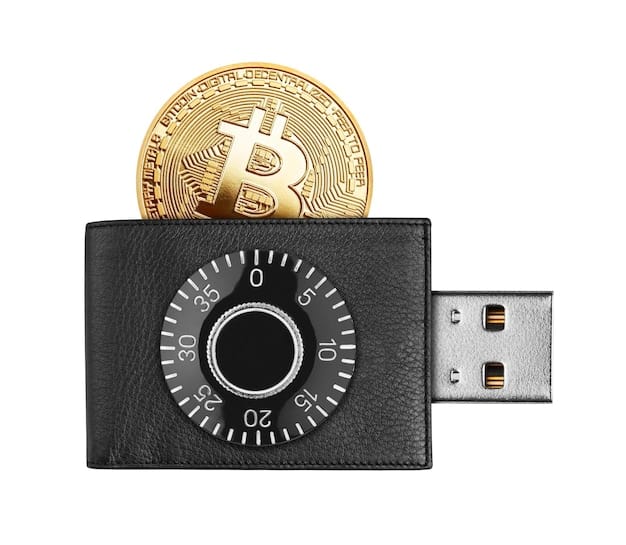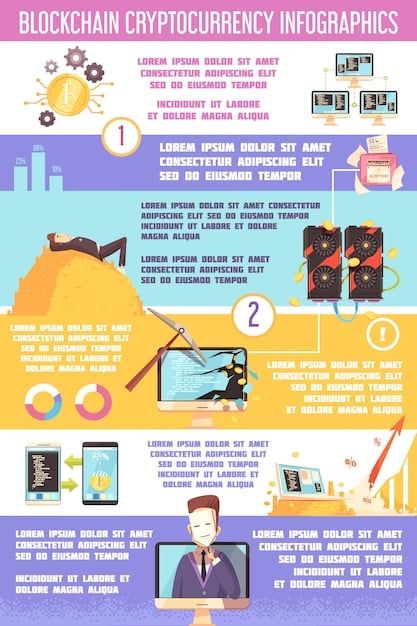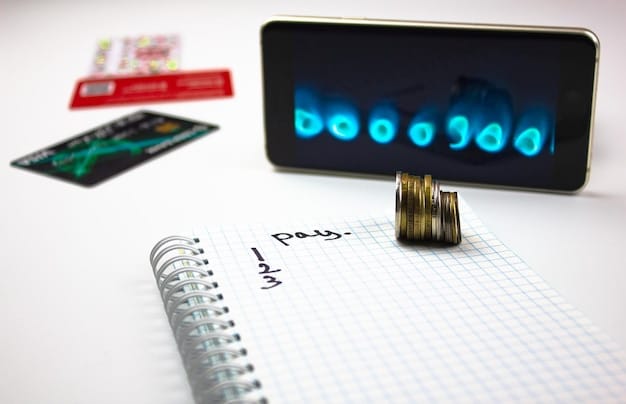Secure Your Crypto: A Step-by-Step Wallet Guide for US Residents

Securing your cryptocurrency wallet is crucial for US residents; this guide offers step-by-step instructions on choosing secure wallets, enabling two-factor authentication, and implementing best practices to protect your digital assets from theft and unauthorized access, ensuring your investments remain safe.
Protecting your cryptocurrency is paramount in today’s digital landscape. This guide provides US residents with a step-by-step approach on how to secure your cryptocurrency wallet and keep your digital assets safe.
Understanding Cryptocurrency Wallets
Cryptocurrency wallets are essential for storing, sending, and receiving digital currencies. Choosing the right type of wallet and understanding its security features are paramount to protecting your investments.
Types of Cryptocurrency Wallets
There are several types of cryptocurrency wallets, each with its own level of security and convenience.
- Hardware Wallets: Physical devices that store your private keys offline, providing the highest level of security.
- Software Wallets: Applications installed on your computer or smartphone, offering a balance between security and accessibility.
- Online Wallets: Web-based wallets that store your private keys on a server, providing convenience but posing greater security risks.
Key Concepts
Furthermore, it’s also important to understand a few key concepts when discussing cryptocurrency wallets. These include public keys, private keys, and seed phrases.
- Public Key: Like an email address, the public key is what you share for receiving digital currency.
- Private Key: Like a password, the private key allows you to access and manage crypto in the wallet. It must be kept secure.
- Seed Phrase: A set of 12-24 words generated during wallet setup. It is a backup used to recover the wallet if you lose access.
Understanding the different types of cryptocurrency wallets and these key concepts is crucial for US residents looking to secure their digital assets. Hardware wallets often provide the best security, while software wallets offer more convenience and are installed on devices such as smartphones. Online wallets are convenient, but they pose greater security risks.

Choosing a Secure Wallet
Selecting a secure wallet is the first step in protecting your cryptocurrency. Consider the following factors when making your choice.
Evaluate Security Features
Check for security features like two-factor authentication (2FA), multi-signature support, and encryption.
Research Wallet Providers
Look for established and reputable wallet providers with a history of security and reliability.
Furthermore, you should consider user reviews and community feedback when picking your crypto wallet.
- Check User Reviews: Look for reviews that discuss the wallet’s security and ease of use. It is important to see what other users experiences and opinions are.
- Consult Community Feedback: Engage with online forums and communities to gather insights from experienced cryptocurrency users and understand what they prefer.
Choosing a secure wallet involves evaluating the security features offered and researching the reputation of the wallet provider. By prioritizing security and conducting thorough research, US residents can minimize the risk of losing their digital assets.
Enabling Two-Factor Authentication (2FA)
Two-factor authentication adds an extra layer of security to your wallet, making it harder for unauthorized users to access your funds. This is one of the most crucial aspects for users to focus on when considering how to secure your cryptocurrency wallet.
How 2FA Works
2FA requires you to enter a code from your smartphone or email in addition to your password when logging in.
Setting Up 2FA
Most wallets offer 2FA options, such as Google Authenticator or SMS verification.
Consider these tips:
- Use Authenticator Apps: Apps like Google Authenticator or Authy offer better security than SMS verification.
- Backup Codes: Save your backup codes in a secure location in case you lose access to your 2FA device. Treat them like the key to your house – keep them very protected.
Enabling two-factor authentication is a critical step in securing your cryptocurrency wallet. By requiring a second form of verification, 2FA significantly reduces the risk of unauthorized access, protecting your digital assets from potential theft.
Using Strong Passwords and Seed Phrases
Strong passwords and secure seed phrase storage are fundamental to protecting your cryptocurrency wallet. These are the keys which unlock access to your crypto wealth.
Password Requirements
Use a strong, unique password for your wallet that includes a combination of letters, numbers, and symbols. The longer the password, the harder it is to crack. Password managers can help with this.
Securing Seed Phrases
Your seed phrase is the backup for your wallet. Store it offline in a safe place, away from potential hackers.
- Write it Down: Write down your seed phrase on a piece of paper and store it in a secure location.
- Metal Storage: Consider using a metal storage device to protect your seed phrase from fire and water damage.
Using strong passwords and securely storing your seed phrase are essential practices for securing your cryptocurrency wallet. A robust password protects against unauthorized access, while a securely stored seed phrase ensures you can recover your funds if your wallet is lost or compromised.
Regularly Updating Software and Security Protocols
Keeping your wallet software up to date and following the latest security protocols are essential for protecting your cryptocurrency from emerging threats.
Software Updates
Install software updates promptly to patch security vulnerabilities.
Staying Informed
Keep up with the latest security news and best practices to protect your assets.
Remember the following!
- Subscribe to Newsletters: Stay up-to-date on the latest security threats and vulnerabilities.
- Follow Security Experts: Monitor the advice of trusted security experts in the cryptocurrency community.

Regularly updating your wallet software and staying informed about the latest security protocols are crucial for maintaining the security of your cryptocurrency. Timely software updates patch vulnerabilities, while staying informed helps you anticipate and mitigate potential threats proactively.
Monitoring and Backup Strategies
Regularly monitor your cryptocurrency wallet for suspicious activity and implement backup strategies to ensure you can recover your funds in case of an emergency.
Transaction Monitoring
Check your transaction history regularly for unauthorized transactions.
Wallet Backups
Create regular backups of your wallet and store them in a secure location.
Further strategies include:
- Multiple Backups: Create multiple backups and store them in different locations.
- Test Restorations: Periodically test your backups to ensure they are working properly.
Monitoring your wallet for suspicious activity and implementing robust backup strategies are essential for protecting your cryptocurrency. Regular monitoring helps you detect and respond to unauthorized transactions promptly, while backups ensure you can recover your funds in the event of a wallet failure or security breach.
| Key Point | Brief Description |
|---|---|
| 🔐 Wallet Choice | Select hardware for security or software for balance. |
| 🔑 2FA | Enable Two-Factor Authentication for secure access. |
| ✍️ Seed Storage | Securely store your recovery seed phrase offline. |
| 🔄 Updates | Keep wallet software up-to-date for the latest security patches. |
FAQ
▼
A cryptocurrency wallet is a digital tool used to store, send, and receive digital currencies. It holds your private keys, which allow you to authorize transactions on the blockchain network.
▼
Two-factor authentication (2FA) is an added layer of security that requires a second verification method in addition to your password when logging into your wallet. This can be a code from an authenticator app or an SMS code.
▼
Your seed phrase is the backup for your wallet. If you lose access to your wallet, you can use your seed phrase to recover your funds. It is crucial to store it securely offline.
▼
You should update your wallet software as soon as updates are available. These updates often include security patches that protect your wallet from the latest threats and vulnerabilities.
▼
If you suspect your wallet has been compromised, immediately transfer your funds to a new, secure wallet. Change your passwords and security settings, and report the incident to the wallet provider and relevant authorities.
Conclusion
Securing your cryptocurrency wallet is critical for protecting your digital assets. By following these steps—choosing a secure wallet, enabling 2FA, using strong passwords, backing up your seed phrase, and staying informed about security practices—US residents can significantly reduce the risk of losing their cryptocurrency. Stay vigilant and proactive in protecting your investments.





